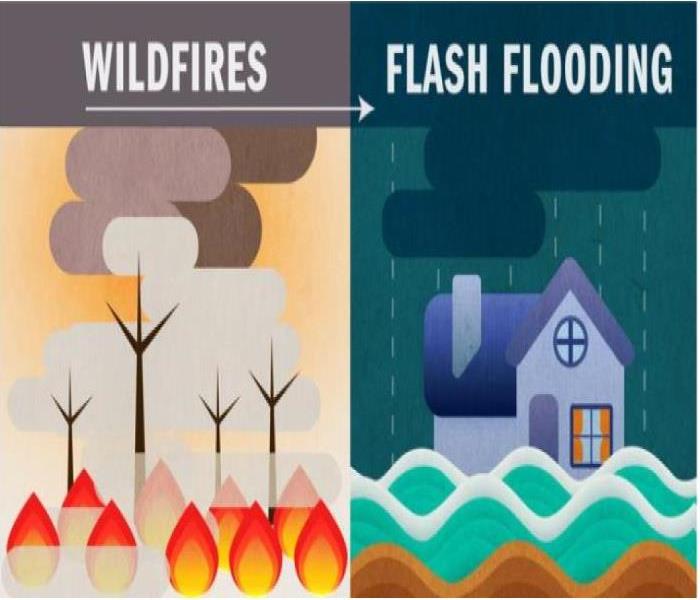Flooding After Wildfires in Riverside County – Reduce Your Risk
12/3/2018 (Permalink)
Flooding is the most common and costly natural hazard in the nation.
Wildfires carry a one-two punch. After the damage caused by the wildfire, flooding is the most common and costly natural hazard in the nation. And, after the record-breaking wildfires in California, the risk of flash flooding and mud flows increase significantly. Even light rain can lead to devastating flash flooding and mudflows.
Residents of California’s Riverside, Los Angeles, Butte, Ventura counties and surrounding areas are urged to protect themselves by planning evacuation routes, collecting supplies and purchasing flood insurance today. Even if your home was not directly impacted by the wildfires, you are at increased risk of flooding. All surrounding areas are at risk of flooding for up to several years. To learn more, visit FEMA-Flood-after-fire.
Large-scale wildfires like Holy, Camp, Hill and Woolsey will dramatically alter the terrain and ground conditions. Normally, vegetation absorbs rainfall, reducing runoff. Wildfires, however, leave the ground charred, barren and unable to absorb water, creating conditions ripe for flash flooding and mudflow. Flood risk remains significantly higher until vegetation is restored—up to five years after a wildfire. Flooding after a fire is often more severe, as debris and ash left from the fire can form mudflows. As rainwater moves across charred and denuded ground, it can also pick up soil and sediment and carry it in a stream of floodwaters, which can cause more significant damage.
A flood does not have to be a catastrophic event to bring high out-of-pocket costs; and you do not have to live in a high-risk flood area to suffer flood damage. Around 20 percent of flood insurance claims occur in moderate-to-low risk areas.
Property owners should remember to:
Buy Flood Insurance. Most standard homeowner’s policies do not cover flood damage. Flood insurance is affordable and important to protecting your investment. By law, there is a 30-day waiting period from the date of purchase until the flood insurance coverage takes effect.
Just an inch of water in an average-sized home can cause more than $25,000 in damage. An average flood policy costs around $890 a year, and rates start at less than $516 a year for homes in moderate- to low-risk areas.
Prepare Now. Gather supplies in case of a storm, strengthen your home against damage, and review your insurance coverages.
Plan Ahead. Plan evacuation routes. Keep important papers in a safe, waterproof place. Conduct a home inventory; itemize and take pictures of possessions and the inside and outside of your home.
For more information about flood insurance, please call your insurance agent or contact the National Flood Insurance Program Call Center (NFIP) at 1-800-621-3362 for information about the NFIP or questions about an existing policy.
Visit the National Flood Insurance Program at FEMA National Flood-Insurance Program to learn more about flood risk and flood insurance.
Getting Prepared-Evaluating your Property
After a fire, it is important to thoroughly evaluate and plan for storm events in order to help protect your property. First, start by determining where water and debris are likely to flow and collect. Once you have located potential routes where water and debris may flow, plan and implement diversions in those identified flow pathways. Pay particular attention to steep, barren slopes, low spots, and high flow areas when planning for structure and property protection. General Precautions During a storm event, property damage can be attributed to stormwater runoff, debris (mud, rocks, branches, etc.), or both. When devising a protection strategy for your property, pay special attention to the following general rules:
o Never underestimate the power of stormwater and debris flows.
o Try to direct stormwater and debris flows away from any structures.
o Avoid altering natural or existing drainage patterns in a way that might worsen conditions for you or your neighbor. Work cooperatively with your neighbor to achieve the best results.
o Avoid trying to control or confine flows more than is absolutely necessary; remember that the water and debris flows need to go somewhere.
o Place protection devices in such a way so as to deflect debris; do not try to create a dam or stop the flows in any way; this may cause flooding.
o In extreme condition, board up windows as necessary to prevent debris from entering structures.
o Protect your most valuable property first - your home; then consider what time and money are available to protect other less valuable objects such as swimming pools, landscaping, or other minor structures.
o Be prepared to sacrifice the use of portions of your property to achieve the greatest amount of protection.
o Don’t take unnecessary risks; if your debris control problems appear to warrant solutions beyond the scope of this guide, consult a competent expert such as a civil or geotechnical engineer or a landscape architect for additional advice.
To get life back on track after flooding and storm damage, call SERVPRO of West Riverside City 951-351-8033






 24/7 Emergency Service
24/7 Emergency Service
